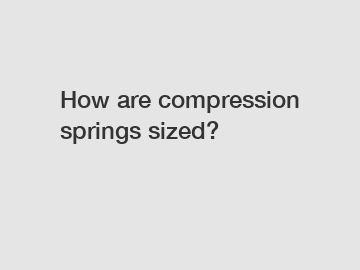How are compression springs sized?
Compression springs are sized based on a combination of factors including wire diameter, outer diameter, free length, and number of coils. These dimensions are carefully calculated to ensure that the spring can provide the necessary force and deflection for its intended application.
The size of a compression spring is primarily determined by the wire diameter. A thicker wire diameter will result in a stronger spring with a higher load capacity, while a thinner wire diameter will result in a weaker spring with a lower load capacity. The outer diameter of the spring also plays a role in determining its size, with a larger outer diameter typically resulting in a higher load capacity.
The free length of the spring, or the length of the spring when it is not under any load, is another important factor in determining its size. A longer free length will result in a spring with a greater travel distance, while a shorter free length will result in a spring with a shorter travel distance. The number of coils in the spring also affects its size, with a greater number of coils typically resulting in a softer spring with a lower load capacity.

To determine the correct size of a compression spring for a specific application, engineers use a combination of mathematical calculations and experimental data. By analyzing the requirements of the application, such as the amount of force that needs to be exerted and the amount of deflection that is needed, engineers can calculate the necessary dimensions of the spring.
Once the size of the compression spring has been determined, it is crucial that the spring is manufactured to precise tolerances to ensure that it will perform as expected. Any deviations from the specified dimensions can result in a spring that is either too weak or too strong for the application.
In conclusion, the size of a compression spring is a critical factor in ensuring that it will provide the necessary force and deflection for its intended application. By carefully selecting the wire diameter, outer diameter, free length, and number of coils, engineers can design a spring that meets the specific requirements of the application. Additionally, manufacturing the spring to precise tolerances is essential to ensure that it will perform reliably and consistently.
Contact us to discuss your requirements of China Custom Coil Springs For Automotive, Heavy-duty tension springs for mining equipment, Electromagnetic shock absorbers for seismic isolation systems. Our experienced sales team can help you identify the options that best suit your needs.



Comments